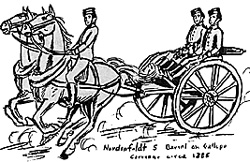
First, there are a few basic points to consider, sticking primarily to the unshielded rifles of the Krupp/Debange systems of about 1873-1895.
- a. The ranges of these weapons exceeded 6,000 yards, but
indirect fire was uncommon, so for practical purposes the field pieces
should be of range limited only by consideration of line of sight.
b. Beaten zones were practically narrowed by angle of impact and percussion fusing. Ranging on a new target at intermediate distances or long range would seriously limit weight of metal. Each field piece on the table should be obliged to roll a 5-6 at over 2,000 yrds (100") or 4-5-6 over 1,000 yrds against targets moving at infantry speed.
Once on target two dice are rolled per turn until the enemy passes from view. A hit is achieved with each 4, 5, or 6. Each hit must be confirmed by rolling to get an even number against skirmishes, removes one figure automatically against a line, or two figures against a column of battle or a square. The column of march is equal to a fine.
Six hits should reduce the defensive bonus of a normal building, but variable defensive bonuses can be assigned different buildings or a field. With each hit, roll a dice to confirm the removal of a figure from the garrison. Stiffer defensive bonuses should be assigned earthworks -- an even number being required to confirm death or injury of an entrenched soldier after 6 turns of digging, 4 or 6 after 12 turns, 6 only after 18 turns.
Cavalry or limbered artillery must be ranged each turn if trotting or at a faster pace.
In counter battery fire the first hit reduces gun fire to 1 die per turn, and the second hit on a battery results in the rolling of a die to see if gunners or horses were most affected, even-the gun may no longer fire, odd-if no nearby hiding place is available for the teams, the gun may not be moved. The third hit eliminates the battery as a fighting unit.
Musketry may achieve the above results, but on the base of killing gunners or horses. A battery with less than half its 5 man crew, or more than 2 hits on horses will be unable to fire in the first case, or move in the second.
Neither cannon nor machineguns are required to "range" under 500 yds. Over 500 the machinegun rolls 2 dice at new targets, 3 at pre-ranged targets, hits as for artillery except that against protected targets the machinegun fires a 1 base of jagers. Fire on batteries by machine guns is presumed to leave ordnances intact, so that the guns may be used if recrewed by artillery, moved if draft horses are available.
Cavalry guns or machineguns move as heavy cavalry but do not charge. The tactical mobility of other artillery is limited to the slow trot when in the field. A cavalry machinegun may fire at the end of a trot move, but other artillery weapons may go no further than a walk if unlinking and firing. Pieces limbered and moved may not fire in the same turn.
These rules, of course, are just suggestions for those who may raise colorful and inexpensive period armies.
Adaptions to "Colonial Wars" may be made quite easily by allowing for enormous numbers of ill equipped Zulus (latest Airfix set, various types available from Scruby, Alberken, and others for some time), Bedouins, etc.
Most colonial wars fail to take into account the enormous fire advantage of breech loading rifle over throwing spear in order to permit a lesser disparity of numbers, but that decision must be left to the reader.
Back to The Armchair General Vol. 1 No. 3 Table of Contents
Back to The Armchair General List of Issues
Back to MagWeb Master Magazine List
© Copyright 1999 by Pat Condray
This article appears in MagWeb (Magazine Web) on the Internet World Wide Web. Other military history articles and gaming articles are available at http://www.magweb.com
